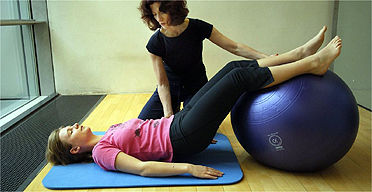
Getting started
You've almost certainly heard of Pilates, but you may not know exactly what it is. The series of precise, controlled exercises was developed by a German man, Joseph Pilates, as a way of overcoming his own physical shortcomings, caused by childhood ailments. Pilates emigrated to the US in the 1920s and opened a studio in New York, where his method quickly became popular among the dance community. He continued to develop and advance the Pilates method until his death in 1967.
Find a teacher
There is no single UK governing body for Pilates - various organisations certify teachers, and their courses vary. Good bets include teachers trained by The Pilates Foundation (07071 781859, pilatesfoundation.com), Alan Herdman Pilates (020-7723 9953, alanherdmanpilates.co.uk) and Body Control Pilates (020-7379 3734, bodycontrol.co.uk).
Mat v studio
Pilates can be done in two ways. Studio classes use special machines equipped with straps, springs and pulleys to facilitate muscle lengthening and strengthening. Mat-work classes are predominantly equipment-free, perhaps using only basic items such as blocks . Neither is better - indeed Alan Herdman recommends everyone start with mat classes, which are cheaper and more widely available.
Home practice
A book or DVD can be a useful addition to your class practice, but it's best to learn the basic principles from an instructor. Pilates Fitness Beginning Mat Workout (Gaiam, £12.99) or Pilates Body with Lynne Robinson (Firefly, £12.99) DVDs are good for newbies. If you already know the basics, try Darcey Bussell: Pilates for Life (Virgin, £17.99). Bookwise, check out Alan Herdman's Pilates Plus, aimed at 50+ participants or Busy Person's Guide to Pilates (both Gaia). I also like Kellina Stewart's Pilates At Home (£10.99, Carroll & Brown), which is spiral-bound and stands up on the floor for easy reference.
What the expert says ...
Former dancer Alan Herdman set up the UK's first Pilates studio in 1970 after studying in New York with Joseph Pilates' original students. He still teaches as well as writing, lecturing and training instructors in Pilates.
Don't be a purist
There are many different styles of Pilates. Some people criticise nonpurist forms for not being true to Joseph Pilates' original methods, but it doesn't have to be 'classic' Pilates to be good. Remember, Pilates died in 1967 (at the age of 87) - if he was still alive today he would be doing some things differently.
Use your brain as well as your body
Pilates takes focus. Try to 'think' yourself into the body part you are working on. Focus on the process of the exercise rather than the outcome. But don't try too hard: that causes you to tense.
Get your core contractions right
Recruiting and working the deep abdominal muscles - the transversus abdominis and internal obliques - is a key part of Pilates, but many people find it difficult to locate these muscles. Lie on your side, with knees bent, heels in line with spine and a pillow between your thighs. Rest your head on your outstretched arm with your back in a neutral position. Allow your tummy to fall forward - completely relax the muscles. Then, keeping the spine still, slowly draw the abs up and away from the fl oor and in towards the spine. Imagine yourself 'collecting them in'. It's much easier to feel the muscles working in this position than when upright or on your back.
Find the right teacher
It's crucial you find a well-qualified, experienced teacher. Find out where the teacher trained, how long it took, and what their background is. These days, you can almost train to be a Pilates instructor on the internet. If you have specific problems , it's better to have an individual lesson or go to a smaller class where you can get personal attention. Also, if the teacher's style doesn't work for you, look elsewhere.
Breathe easy
There is a lot of focus on the breath in Pilates - we talk about 'lateral' breathing, where you try to breathe more into the back, and some movements are coordinated with breathing patterns. Don't get too hung up on getting the breathing techniques right - the main thing is that you breathe rather than hold your breath.
Be patient
To get the best results, you need to give it time and commitment. And don't try to progress too quickly.
The gear
You can wear pretty much anything to a class, as long as it's comfy and you can move freely. You have bare feet.
The only equipment you really need is a mat. A Pilates mat, such as the Stott Pilates Express mat (£32.99, from Proactive Health, 0870 848 4842, proactive-health.co.uk) is thicker than a yoga mat, to support the spine, and non slip for safety. You may also want a head support (£8.99, from Pilates Plus, 020-8892 3403, pilates-plus.co.uk). Pilates rings (circles), blocks and balls can also be useful. Gaiam's BodyRing Kit contains a 14-inch flexible metal ring to add resistance to mat work and a 40-minute DVD workout (£24.99, from Gaiam Direct, 0870 241 5471, gaiamdirect.co.uk).
You can buy your own 'studio' equipment to use at home . NordicTrack does a basic Reformer for £149 (from CCSports, 0800 783 6032, ccsports-online.co.uk), or you can go the whole hog and spend £2,787 on the Stott Pilates Pro Reformer (from Proactive Health, as before).
On the downside
No discernible aerobic benefits
An American Council on Exercise study found that Pilates elicited a heart rate equating to 54% of subjects' maximum: lower than the recommended guidelines for aerobic training.
Tricky to master
You need to be in it for the long haul.
Expensive
Studio classes can cost £20-£50 a session.

